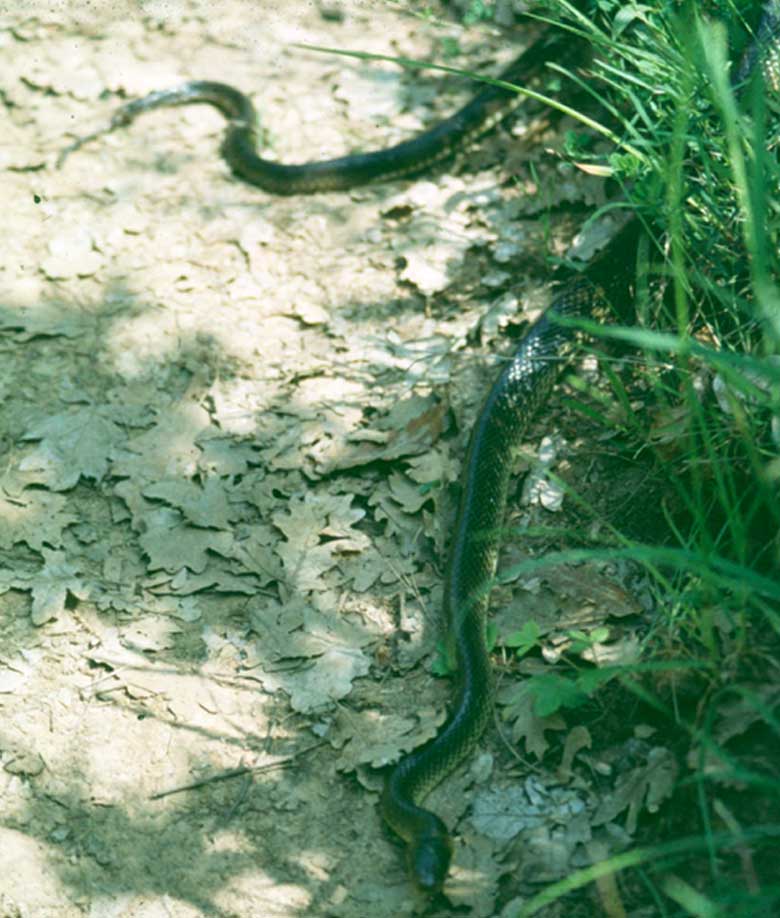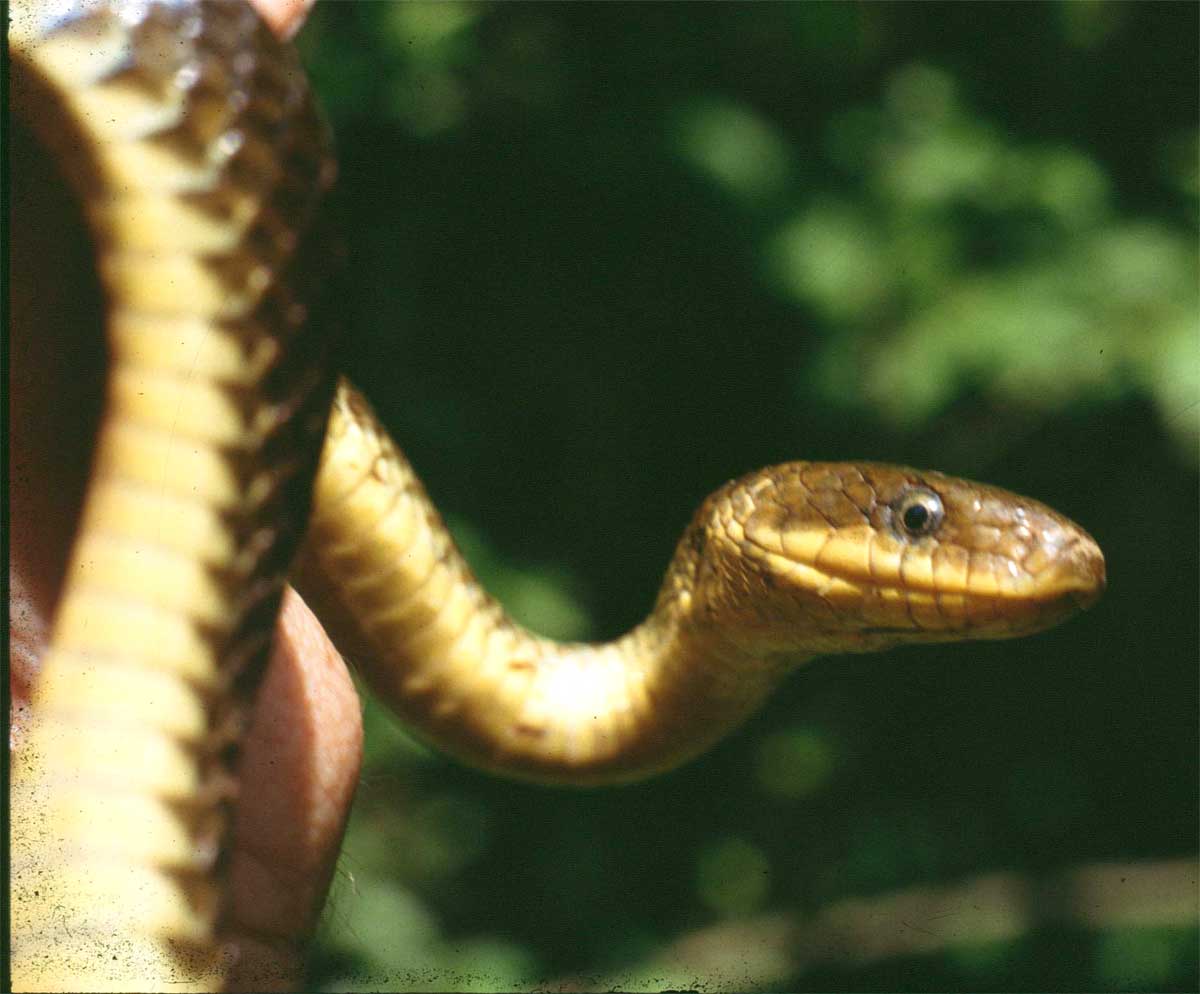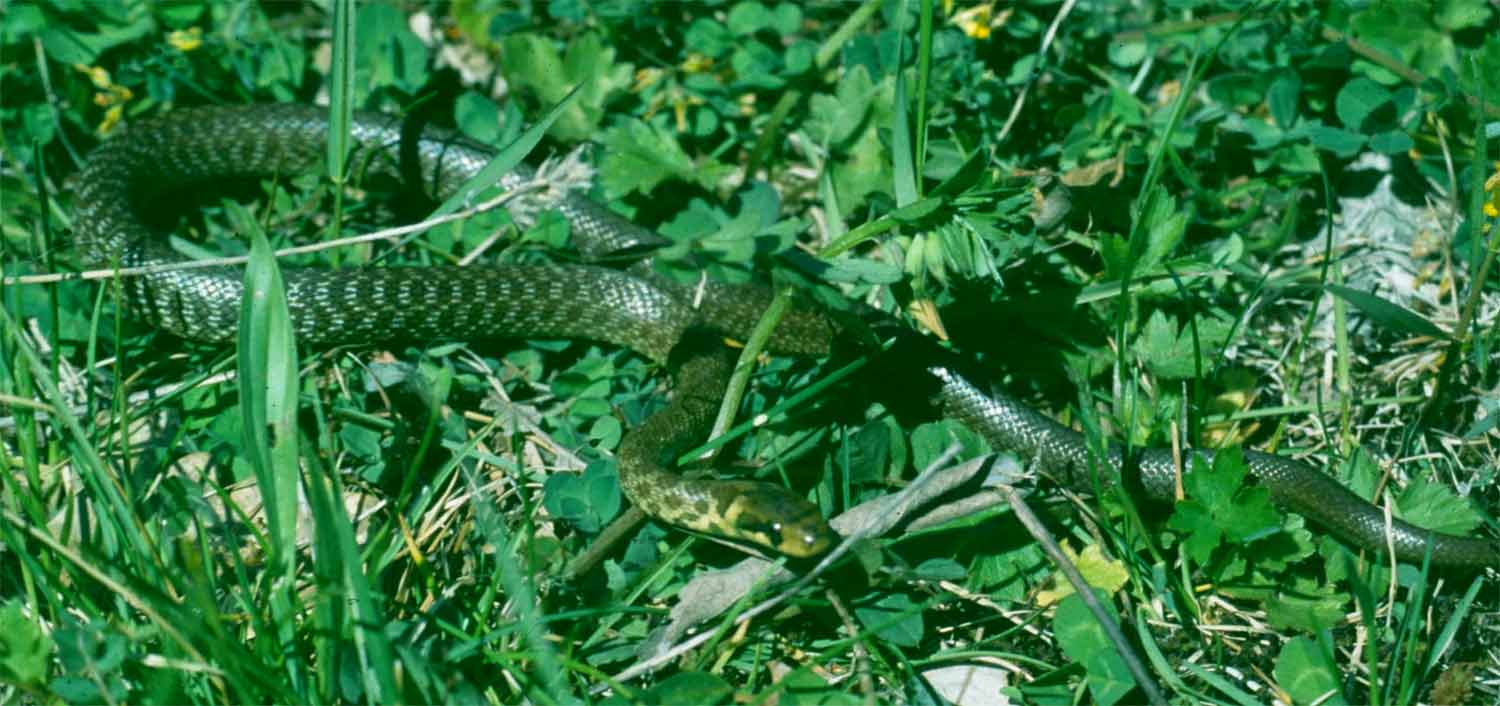 |
 |
Is Aesculapian snake still around?: |
| Author | Message |
|
-LAF Senior Member Joined: 03 Apr 2003 No. of posts: 317 View other posts by -LAF |
Posted: 08 Apr 2003 I have read in several places that back in the early 80's a gravid female Aesculapian snake escaped from Colwyn bay mountain zoo in north wales and subsequently gave birth. I would like to know if anyone one knows if there have been any recent sightings to suggest this colony may still be present. For my masters degree I am producing a photographic field guide to Britains reptiles and would be interested in including a section on non-ntive but established species. So far I have wall lizards (n.b. are all locations the same species of Podarcis?), and Red-Eared sliders pencilled in for this section but any other suggestions would be greatly appreciated. Many thanks, Lee. Lee Fairclough |
|
Caleb Forum Coordinator Joined: 17 Feb 2003 No. of posts: 448 View other posts by Caleb |
Posted: 09 Apr 2003 I don't know if you've seen my page at http://www.darkwave.org.uk/~caleb/ukintro.html on the introduced species... Beebee & Griffith's book implied that they were still around, but gave no references. It might be worth emailing them to ask where the information came from. I visited the area in the late 80s and had a good look for them, but with no success. |
|
Gemma Fairchild Krag Committee Joined: 14 Feb 2003 No. of posts: 193 View other posts by Gemma Fairchild |
Posted: 09 Apr 2003 Lee, Take a look on the species identification page, I hope I am getting towards an exhaustive list of introduced, established and dangerous aliens. (The red ear is not strictly established, as far as I know there are no records of successful breeding, though I think there have been unhatched eggs found in the wild.) Only addition for reptiles is the Green Lizard (Lacerta viridis) or (L.bilineata) Over the next few months I will attempt to put up info on each of the species including current distribution or last sightings - if you find any info it would be greatly appreciated for the pages. (with reference) ----RAUK e-Forum---- 
|
|
David Bird Forum Specialist Joined: 17 Feb 2003 No. of posts: 515 View other posts by David Bird |
Posted: 09 Apr 2003 Aesculapian Snake. I have never been to the North Wales site and have no up to date information but a friend told me about a colony in central London at one of the royal parks a few years ago where he had found immature specimens showing breeding had occured. In all the years I have been visiting the Balkans with hundreds of days in the field I have only seen one adult specimen and found an area in Croatia where quite a few juvenile individuals were seen, so they are not that easy to find in the wild from my experience. Wall Lizard Podarcis muralis all the colonies I have visited Isle of Wight, Somerset, 4 in Dorset, Hampshire and the Sussex coast are of this species. Some look like the Italian subspecies Podarcis muralis nigriventris syn. P.m.brueggemanni whilst a few look like populations from France which are P.m.brogniardi. There is a paper Quayle ,A. & Noble,M. 2000 The Wall Lizard in England British Wildlife Dec.2000 99-106 and a small folded A4 leaflet produced by Ventnor Regeneration Forum,Island 2000 Trust and Wight Wildlife on the Wall Lizard at Ventnor. I do not know of any other species of Podarcis that have become established, I know several people have tried with Podarcis sicula in gardens in the past but they have all disappeared from the site of introduction extremely quickly never to be seen again. British Herpetological Society Librarian and member of B.H.S Conservation Committee. Self employed Herpetological Consultant and Field Worker. |
|
-LAF Senior Member Joined: 03 Apr 2003 No. of posts: 317 View other posts by -LAF |
Posted: 11 Apr 2003 Thanks for all your help, I will continue digging and post anything I uncover on these forums. Another introductee I heard of was Natrix tesselata that apparently bred on Spalding-upon-Holme moor (This was in a book on introduced vertibrates of the British Isles which I can no longer find - or remember the title of - GRrrr!). A lot of that area has gone to peat extraction now anyway so even it it did establish it's probably now lost. As regards the red-eared slider, I know there's no record of them breeding but in many areas they are probably the most frequently seen reptile (Here in Notts anyway), which is sad but a good enough excuse to include them. Again, many thanks for all your comments, much appreciated. Cheers, Lee. Lee Fairclough |
|
David Bird Forum Specialist Joined: 17 Feb 2003 No. of posts: 515 View other posts by David Bird |
Posted: 11 Apr 2003 Lee the book was probably Christopher Lever's The Naturalized animals of the British Isles. I will try to get a list together of books and papers on the introduced species in the next few days and post it with the other bibliographies. British Herpetological Society Librarian and member of B.H.S Conservation Committee. Self employed Herpetological Consultant and Field Worker. |
|
Gemma Fairchild Krag Committee Joined: 14 Feb 2003 No. of posts: 193 View other posts by Gemma Fairchild |
Posted: 18 Apr 2003 Lee, Nick Arnold also states in the second edition of A Field Guide to the Reptiles and Amphibians of Britain and Europe, published in 2002 that Elaphe Longissima survives to this day at Colwyn bay. No reference so you will need to find out direct from him what this statement is based on. ----RAUK e-Forum---- 
|
|
GemmaJF Admin Group Joined: 25 Jan 2003 No. of posts: 2090 View other posts by GemmaJF |
Posted: 18 Apr 2003 How is this for an up-to-date sighting, Gemma Fairchild, Independent Ecological Consultant |
|
-LAF Senior Member Joined: 03 Apr 2003 No. of posts: 317 View other posts by -LAF |
Posted: 22 Apr 2003 Fantastic! Thanks for all those. I actually lived in Bangor (30mins away from Colwyn Bay) for 4 years and never went to look! I might go back to visit shortly! - if I find anything I'll post the pictures. Thanks again, Lee. Lee Fairclough |
|
Matt Harris Senior Member Joined: 03 Jun 2003 No. of posts: 196 View other posts by Matt Harris |
Posted: 01 Jul 2003 Aesculapians - I worked at WMZ for a few months in 1996 and saw roadkill Aesculapians and sloughed skins that the gardeners brought in. Wall lizards - I emailed someone a few years ago, who had put an article in the Natterjack, about the colony at the Cotswold WildlifePark. I was told at the time they were probably P sicula, but it was great to see them whatever they were, crawling onto the giant tortoises to bask etc. Incidentally, you would, strictly speaking,need a license to re-release these non-native species into the wild in the UK. Gwent Amphibian and Reptile Group (GARG) |
|
-LAF Senior Member Joined: 03 Apr 2003 No. of posts: 317 View other posts by -LAF |
Posted: 01 Jul 2003 Hi Matt, that's really interesting news about the Aesculapians! Would you suggest that the population resudes within the zoo grounds (I'm guessing 'gardeners' were zoo staff or outside of it (roadkills)? It would certainly be interesting to see how far this population has spread (although the utter lack of genetic variation *should* prove terminal to the population eventually - but I suppose that island pops can start from 1 gravid female so who knows?). There is also the question of egg laying sites, I suppose that the zoo must produce large amounts of compost, hay piles etc from its large animals, so I wondered if these are ever piled permenantly enough for egg hatching. I get your point on re-releasing, however to re-release first you have to catch and where the definition of that is drawn I'm not sure. To be honest I don't see as this snake will really be competing adversly with the local reptiles. They share the same range as Vipera species in other parts of Europe. And being a highly arboreal rodent/bird specialist I can't see that they're overly negative additions to the local fauna, especially our herps. Do you know if any were ever found a good distance from the zoo? Anyway, interesting infromation, should be going to Colwyn Bay very soon now so will keep you all posted. PS: I will try and check the Cotswold wildlife park out too, if we get sicula and muralis in this country then I should try and get pictures of both! Many thanks, Lee. Lee Fairclough |
|
-LAF Senior Member Joined: 03 Apr 2003 No. of posts: 317 View other posts by -LAF |
Posted: 01 Jul 2003 Sorry, just using this screen to test whether I can delete a post... (says I can at bottom of screen) If you find this I apologise for being too stupid to work it out 
Ta, Lee. Lee Fairclough |
|
Wolfgang Wuster Senior Member Joined: 23 Apr 2003 No. of posts: 326 View other posts by Wolfgang Wuster |
Posted: 01 Jul 2003 Hi Lee, Just heard from my honours project students who does voluntary work at the WMZ: one of the keepers caught an Aesculapian last Monday. (and it caught her...  ) )
There is certainly plenty of bushy habitat around there, and there must tip their lawn clippings somewhere... I don't really see these snakes having any negative impact - after all, theya re found in many parts of central Europe with the same herps, birds and mammals we have here. Hardly a Guam/Boiga iregularis situation. Cheers, Wolfgang Wolfgang Wüster School of Biological Sciences, University of Wales, Bangor http://sbsweb.bangor.ac.uk/~bss166/ |
|
Matt Harris Senior Member Joined: 03 Jun 2003 No. of posts: 196 View other posts by Matt Harris |
Posted: 01 Jul 2003 <<I don't really see these snakes having any negative impact >> Neither do I and I hope they contine to thrive, but with regards to releasing non-native spp., you have to draw the line somewhere, otherwise you're looking at the thin end of the wedge. It is prudent to ban release of non-natives outright rather than have a specialist make a decision as to whether it's release will be detrimental or not. The findings I know of were all within the zoo grounds. At the CWP, the area of wall where the Podarcis hatchlings used to appear in late summer was cemented up because it was getting dangerous. I never saw any juveniles after that. Gwent Amphibian and Reptile Group (GARG) |
|
Wolfgang Wuster Senior Member Joined: 23 Apr 2003 No. of posts: 326 View other posts by Wolfgang Wuster |
Posted: 01 Jul 2003 Hi Matt, I am certainly not condoning additional releases, or releases of anything else anywhere else. However, I am more than happy to see this one thrive, and would be opposed to any move to get rid of them - like you. Cheers, Wolfgang Wolfgang Wüster School of Biological Sciences, University of Wales, Bangor http://sbsweb.bangor.ac.uk/~bss166/ |
|
-LAF Senior Member Joined: 03 Apr 2003 No. of posts: 317 View other posts by -LAF |
Posted: 02 Jul 2003 Wolfgang, thanks for that on the WMZ, I've sent them an enquiry email to see if they've got any from feral stock in captivity (you never know, they might have kept it - or have others). I hope this Colony thrives too (even if the genetic odds are a bit stacked against it - never say never) just think, in a few hundred years time with a uniquely isolated genetic population and we could have a fully new species. Now that would be great, indiginous but not native! lol. On a interesting note, there have been a few fossil records of Elaphe longissima from the late pleistocene in Suffolk (B.H.S. Bulletin no.50 1994) so maybe they should simply be considered a long overdue return. Either way, I think they make a wonderful edition to our fauna. Cheers, Lee. Lee Fairclough |
|
Gemma Fairchild Krag Committee Joined: 14 Feb 2003 No. of posts: 193 View other posts by Gemma Fairchild |
Posted: 02 Jul 2003 The genetics should be interesting for this population. I have a lot of fears about inbreeding depression in isolated populations, but I think it also true that if a population starts with a very limited gene pool but does not reach a limiting factor to the adult population size in the first few generations, there is a good chance that the genetic diversity will increase overall and the population thrive.. someone really should study this! ----RAUK e-Forum---- 
|
|
Chris G-O Member Joined: 14 May 2003 No. of posts: 36 View other posts by Chris G-O |
Posted: 22 Sep 2003 Strictly speaking (!) you can't get a licence to release a non-native species into the wild! Chris Gleed-Owen, Research & Monitoring Officer, The HCT & BHS Research Committee Chair |
|
David Bird Forum Specialist Joined: 17 Feb 2003 No. of posts: 515 View other posts by David Bird |
Posted: 04 Oct 2003 In case people have no idea what Aesculapian Snakes look like I have a few poor pics to post. They were taken in Croatia the 2 metre long adult which is the only one I have ever seen was in the Istrian peninsula nr Porec and was the sorryest looking wild snake i have seen that was still alive. It was moving slowly along a small dirt animal track in some scrub/woodland a few hundred metres from the sea and had obviously been in a few fights with a more powerful opponent in the past it had only a small incomplete tail and numerous scars all over the body of different ages and degree of repair. If I had this snake in captivity I would have certainly been thinking seriously about euthenasia. It gave no resistance when picked up and when released after photgraphing continued to move slowly along the track. The juvenile was taken just on the inland side of the Mosor mountain near Split, several were found in the same area as well as a freshly killed specimen pointed out to me by a member of a football team that were having a picnic and a match on a pitch miles from anywhere. 

 British Herpetological Society Librarian and member of B.H.S Conservation Committee. Self employed Herpetological Consultant and Field Worker. |
|
Davew Senior Member Joined: 12 Jan 2004 No. of posts: 99 View other posts by Davew |
Posted: 12 Jan 2004 Hi, I'm new to the forum but have a bit of info for this thread - apologies for adding to what is probably a dead thread. I saw a single Aesculapian Snake at The Welsh Mountain Zoo in July 2003. I had previously contacted a keeper here and asked to be advised if any were caught. Apparently the snakes occasionally stray into and remain around public areas so need to be captured and released where they may cause less disturbance to visitors. In conversation a rough estimate of 100+ individuals was given for the Zoo and surrounding areas although this must have been a very rough estimate based on road casualties and captures as by nature they are very difficult to see. The individual I saw was approaching four feet and was extremely aggressive cosntantly striking the tank. It was awaiting later release as it was absolutely pouring down and the temperature had dropped.
|
- Is Aesculapian snake still around? |